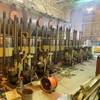The potential for drones to be used for inspections is not new, notes Bureau Veritas, but to date trials have not focused on specific survey requirements for ship structures in enclosed spaces; the RECOMMS project will do just that.
Bureau Veritas has joined RECOMMS (Remote Evaluation of Coatings / Corrosion on Offshore Machinery and Marine Structures / Ships), a joint investment project (JIP), to develop drones with the capability to inspect steel structures in enclosed spaces. The JIP’s primary objectives are to develop a steady, stable and reliable drone capable of following programmable flight paths, either pre-determined by 3D imagery software or flown by a pilot, using 3D simulator ship specific training programs developed in unison with the drone design. This will lead to the development of a complete and marketable inspection drone when delivered with the required software package.
Key investment partners for the confined space ambitions include Akzo Nobel, Barrier Group, Bureau Veritas, Drone Ops, Hempel Paints A/S, Marine Technical Limits and a major oil company. Safinah Ltd, coating specialists and consultants, are the RECOMM project managers.
In the first phase of development the drone will be designed to carry an unobstructed HD camera as well as lighting and batteries with suitable strength, durability and longevity to perform structural and coating inspections within a ballast tank whilst providing reliable clear images fit for comparison with close up inspection.
Jean-François Segretain, Technical Director, Bureau Veritas, Marine & Offshore, said, “The end goal is to be able to survey cargo spaces, ballast tanks and confined spaces remotely and effectively. If we can do this with drones we can help reduce risks to our surveyors and ship crews by minimizing the need, for example, to erect expensive staging whilst covering the survey scope which would otherwise require surveyors to work at height or perform tank inspections by means of rafting.”
It is estimated that eliminating the need for staging erected for class renewal surveys could save in the region of $90,000 for a VLCC or $40,500 for a capesize bulk carrier (based on dry-docking costs in China for ships of ten years and older).
Segretain said, “While a lot of work has been done with drones nothing yet released has led to drones meeting specific requirements for marine classification close up surveys. This project addresses the specific needs of our survey requirements and other inspections.”
As a secondary goal, the project will also address the potential for inspection of open space marine structures such as offshore wind turbine blades. Once tank inspection objectives have been met, the drone will be designed with a payload carrying capacity capable of further developing the attachment of sensoring equipment with the end goal of performing paint and coating application analysis as well as steel thickness measurement. Paint coating and plate thickness gauging equipment manufacturers are already involved with others being encouraged to join the project, in order to develop specialized sensoring equipment suitable for the drone.















